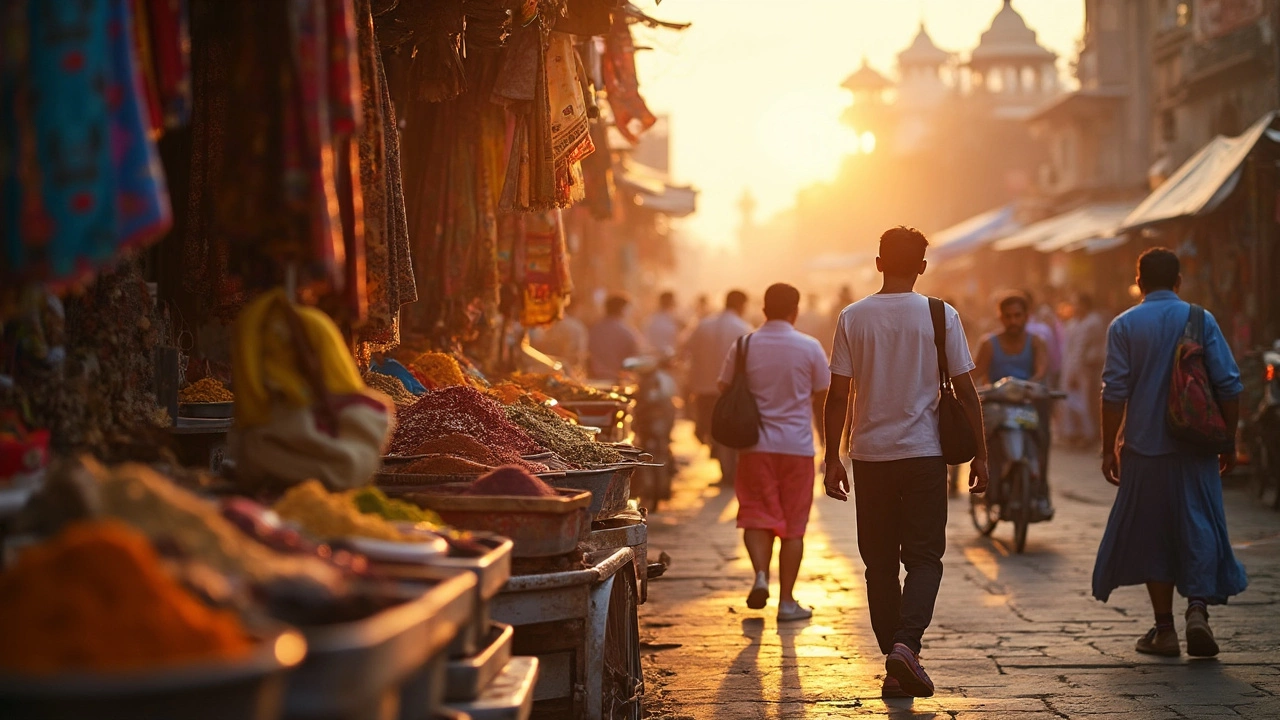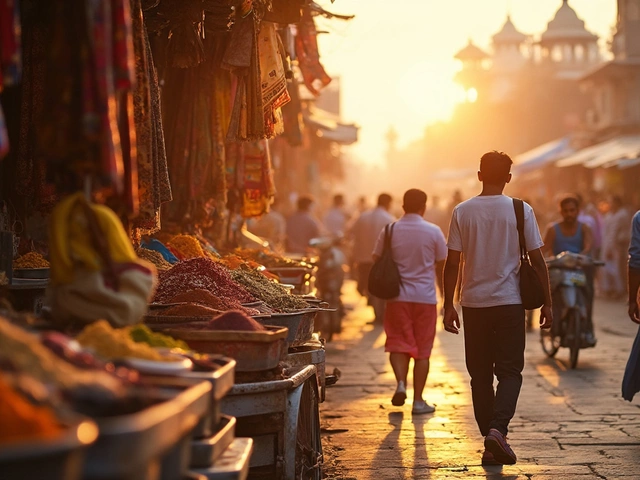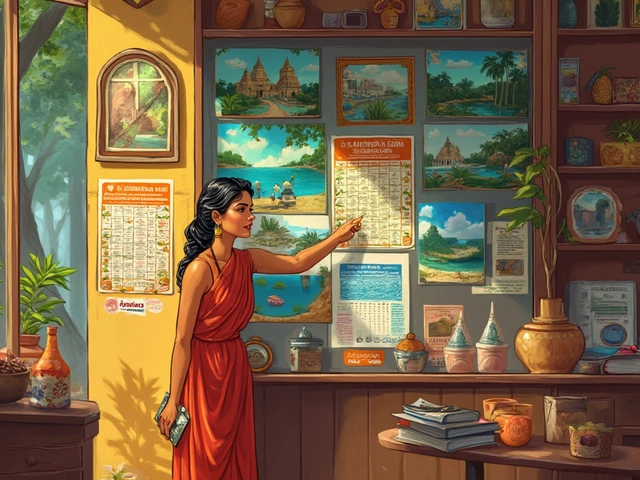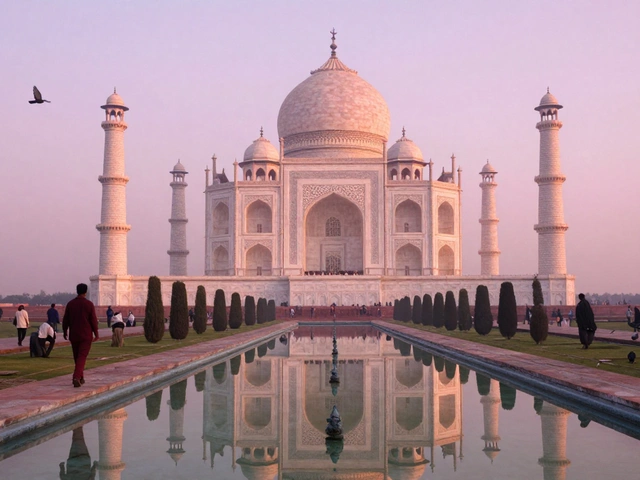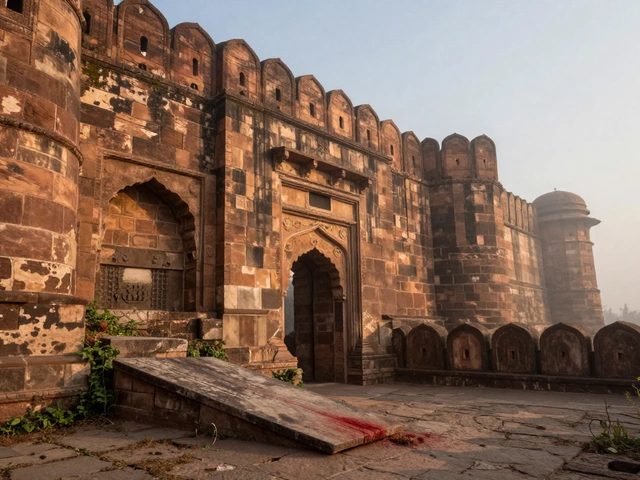If you’re planning to spend real time in North India and you’re not from around here, you’ve probably heard a hundred different opinions about where foreigners should go. There’s no one-size-fits-all answer. What feels perfect for a digital nomad might be totally wrong for someone who’s big on nightlife, or for someone who wants peace and quiet. Not all North Indian cities make it easy for foreigners either—some are way more welcoming, less confusing, and offer better food for sensitive stomachs.
Things you’ll want to think about: Do you care more about historic sights, modern comforts, or friendly locals who are used to foreigners? Maybe you don’t want to spend your afternoons fighting off traffic or navigating unreliable Wi-Fi. Some cities basically roll out the red carpet for travelers, while others are chaotic and intense, but totally unforgettable.
- Deciding What Matters Most
- Delhi: Big City Buzz and Challenges
- Jaipur: Royal Charm with Modern Comfort
- Rishikesh: Chill Lifestyle on the Ganges
- Varanasi: Deep Culture, Not for the Faint-hearted
- Making Your Move: Tips for Foreigners
Deciding What Matters Most
Picking the best city for foreigners in North India always comes down to what type of lifestyle or travel experience you want. You have to start by asking yourself the basics: Will you be working or just touring around? Are you cool with street food and crowded markets, or do you need smooth Wi-Fi and Western toilets everywhere you stay?
Weather is no joke in North India. Summers get brutally hot in places like Delhi and Jaipur (think 42°C and up in May and June). Mountain cities like Manali or Dharamshala, though, stay much cooler. Winters in Delhi can dip lower than people expect, and sometimes air pollution gets seriously bad—Delhi’s air quality index regularly ranks as one of the world’s worst, especially in November and December.
Comfort and safety are right up there, too. Bigger cities are used to tourists, offer better global food options, and more English-speaking locals. That said, pickpocketing and overcharging are annoyingly common in busy areas. Smaller cities can be less hectic, but English proficiency drops and you’ll stand out in a crowd. For things like banking, grocery shopping, or even finding imported toiletries, metros like Delhi, Gurgaon, or Jaipur make life a lot easier.
Transportation is another big one. Delhi’s metro system is fast, cheap, and covers pretty much everywhere you’d want to go. Outside Delhi and a few other big places, you’re usually stuck with rickshaws and auto-taxis, and traffic can be a nightmare, especially before festivals or on weekends.
- For reliable Wi-Fi and coworking spaces: Delhi, Gurgaon, and Noida lead the pack.
- If you want laid-back, yoga vibes with loads of other travelers: Rishikesh tops the list.
- To avoid pollution and heavy traffic: Consider mountain cities, but expect less nightlife and fewer fancy comforts.
So, before you book anything, list your own must-haves. Is it friendly locals? Modern shopping malls? Quick access to train stations or airports? Whatever tops your list will make all the difference in how much you enjoy North India.
Delhi: Big City Buzz and Challenges
Delhi is everything at once: modern, traditional, exciting, and kind of overwhelming. For a lot of foreigners, it’s the first stop in North India, mostly because the flights land here and you can branch out to almost anywhere else by train or plane. What you don’t always hear is how much Delhi can swing between extremes—fancy malls versus ancient markets, street breakfasts for a dollar versus rooftop bars that could be in New York.
The city is huge, with more than 32 million people if you count the whole metro area. It’s loud, busy, and yes, the traffic jams are as bad as everyone says. But you’ll find a ton of international restaurants, decent coffee shops, coworking spaces, and local expat communities, especially in areas like Hauz Khas, Defence Colony, and Greater Kailash. Handy if you crave a taste of home or need reliable Wi-Fi for work.
Here’s what stands out for foreigners who stay a while:
- Tourist-friendly transport: The Delhi Metro is clean, pretty easy to figure out, and cheap. Ubers and autos are everywhere, too.
- Historical sites: Think humongous: the Red Fort, Humayun’s Tomb, Jama Masjid, and Qutub Minar just to name a few.
- Nightlife and food: Delhi has some of the best international food options in India. If you get homesick, you’ll find everything from Korean BBQ to proper thin-crust pizza. Hauz Khas Village and Connaught Place are nightlife hotspots.
- Shopping: From luxury brands in Select Citywalk to the madness of Chandni Chowk, you can buy anything—if you’re willing to bargain hard in bazaars.
- Expat resources: International hospitals (like Max and Fortis), embassies, and loads of language schools are in the city.
Still, Delhi doesn’t sugarcoat its problems. The air quality is a real issue, especially October to January when smog rolls in. Bag snatching and tourist scams happen—keep your stuff close in busy markets. And as for getting things done, patience is key: paperwork moves slow, and customer service can be hit or miss.
When people talk about cost, Delhi is a bit of a chameleon. You can stay on a tight budget or live fancy depending on the neighborhood. Here’s a quick look at what you might expect (June 2025 average prices):
| Item | Cost (INR) | Cost (USD approx) |
|---|---|---|
| Meal at mid-range restaurant | 1,500 | 18 |
| Month rent 1-bedroom | 40,000 (central) | 480 |
| Delhi Metro ride (average) | 40 | 0.50 |
| Monthly coworking fee | 8,000 | 96 |
Word to the wise: stick to bottled water, know which neighborhoods are best at night, and double-check the air quality index before planning a day outdoors. If you want a city with options (and can handle the wild pace), Delhi’s going to keep you busy and well-connected.
Jaipur: Royal Charm with Modern Comfort
Jaipur often pops up as a top pick for foreigners exploring North India. Here, you get a rare mix: a real taste of India's royal past, but without giving up on things like good coffee, Wi-Fi, and clean hotels. The city is famous for its pink buildings and massive forts, but it’s also full of expats, digital nomads, and students from around the world.
The best city for newcomers isn’t just about ticking places off a travel list. Jaipur makes daily life practical for foreigners. The roads, while still busy, aren’t as chaotic as Delhi’s. English is widely spoken, especially around tourist spots and hotels. If you need a SIM card, ATMs, or delivery apps, you'll find them easy to use. 24/7 pharmacies and western-style supermarkets make adapting way less stressful.
- Sightseeing’s a breeze: Must-sees like the Amer Fort, City Palace, and Hawa Mahal are all within easy reach—cheap Uber rides get you there with no hassle.
- Cafés and coworking: Fancy a spot to work? Jaipur has plenty of bright cafés with decent Wi-Fi and menus that go beyond spicy curries. Coworking hubs like The Maker’s Space attract expats.
- Shopping: Forget basic souvenirs. Jaipur’s markets (like Johari Bazaar) are packed with handmade jewellery, crafts, and block-printed textiles. Don’t be afraid to haggle–locals expect it.
If safety tops your list, Jaipur scores well for solo travelers, especially women. Streets are better lit than most Indian cities. There’s even a tourist police force dedicated to helping foreigners who might get scammed or confused.
Plenty of expats stick around for months at a time—some teach, some work remotely, and some just soak it all in. Social events like yoga classes, rooftop movie nights, and food tours make it easy to meet new people. And if you want a direct train to Delhi or Agra for a quick weekend, Jaipur’s railway station is well-connected.
| Fact | Details |
|---|---|
| Population (2025 est.) | ~4.2 million |
| Average meal cost (mid-range restaurant) | ₹350-600 ($4-7) |
| Best travel season | October to March |
| Number of coworking spaces | Over 20 |
| Main foreign visitor demographics | UK, USA, France, Australia |
A tip: Pick guesthouses or hotels near C-Scheme or Civil Lines for fewer crowds and more reliable amenities. Most places offer airport pickup, which is a life-saver after a long flight. Jaipur strikes a sweet balance for foreigners—lots to do, but without overwhelming first-time visitors.
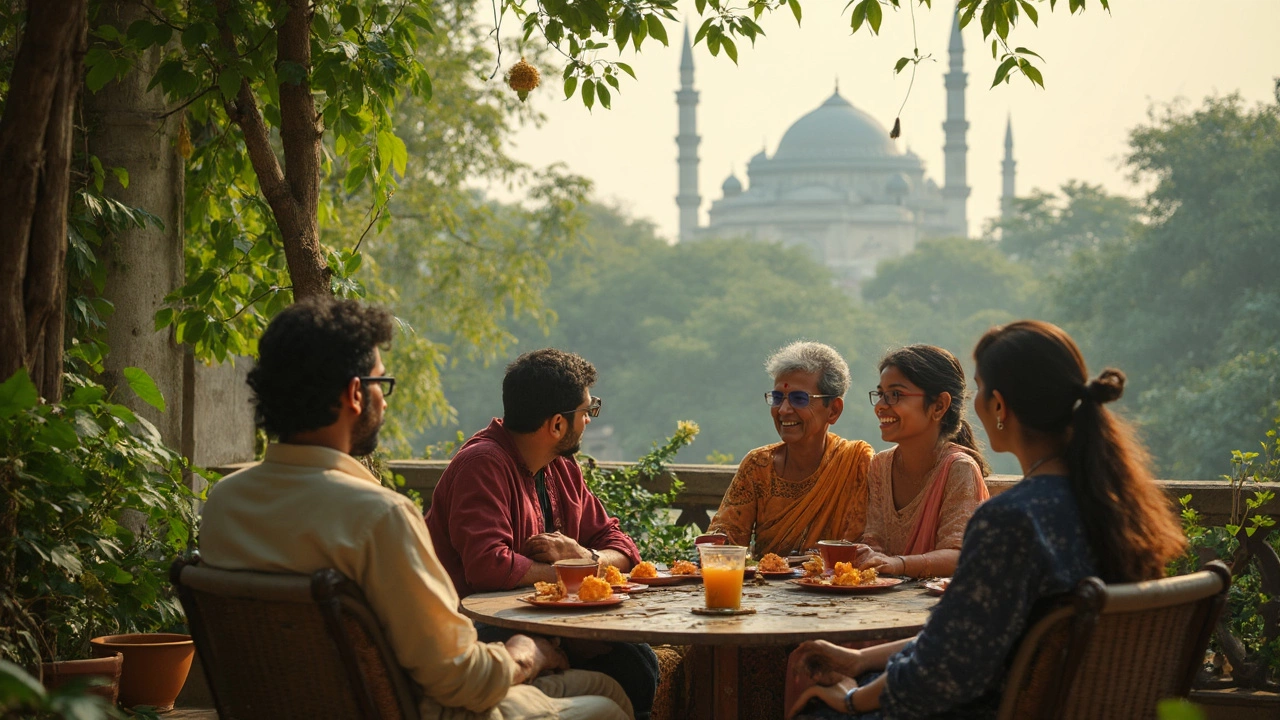
Rishikesh: Chill Lifestyle on the Ganges
Rishikesh is where foreigners go when they want to slow down, stretch out, and maybe even learn a little about themselves. It's right on the banks of the Ganges River, about 240 km from Delhi, and has become a top pick for anyone looking for yoga retreats, river rafting, or just a peaceful spot to work remotely. Rishikesh isn’t loaded with nightclubs or huge shopping malls, but it makes up for that with calm vibes and lots of international visitors—so you never feel totally out of place.
Since the early 1960s (yes, when The Beatles came to visit), Rishikesh has been called the “Yoga Capital of the World.” Tons of yoga schools pop up along the river, offering everything from beginner classes to month-long teacher training. Most places are well organized for non-Indians—English is everywhere, and menus at cafes in Tapovan and Laxman Jhula are full of Western foods, plus vegan and healthy options for everyone who’s tired of curries.
It’s more than just yoga here. You can try white-water rafting, mountain biking, zip lining, and visit the Beatles Ashram, which attracts musicians and Instagrammers from all over. Foreigners who want to stay longer often rent small apartments or rooms, which are much cheaper than Delhi or Jaipur. Internet is surprisingly good if you stick to tourist-friendly guesthouses or cafes.
| Rishikesh Facts for Foreigners | Details |
|---|---|
| Population | ~100,000 |
| Peak Tourist Months | October to April |
| Visa On Arrival | Available for many countries |
| Average Rent (1 bed per month) | Rs. 8,000–15,000 |
| English Spoken | Widely, especially in tourist areas |
Most people love that Rishikesh is a best city in India for detoxing—meat and alcohol are banned within city limits. If you’re a party animal, this isn’t your scene, but for anyone into fitness, vegetarian food, or spiritual stuff, it hits the spot. There’s street food everywhere but it’s not overwhelming, and most stalls are used to tourists asking about cleanliness. Medical facilities are solid for basic needs, though for anything serious you’d head to Dehradun (an hour away).
- Tip: For long stays, sort out your visa early. The yoga tourist visa gets a lot of use here.
- Tip: Visit in winter (it’s chilly but not bone-cold), and avoid summer when it’s packed with local families.
- Tip: If you’re working remotely, ask hosts about Wi-Fi speeds before booking—some spots aren’t as speedy as advertised.
Daily life is easy to figure out, people are friendly, and there’s always a new café to try. Just be ready to wake up early—the day starts with sunrise yoga, not late-night parties.
Varanasi: Deep Culture, Not for the Faint-hearted
Varanasi isn’t everyone’s first choice, and that's totally understandable. It’s loud, busy, and full of smells and sounds that just hit you all at once. But if you're after real, deep Indian culture, Varanasi stands out like nowhere else. People call it one of the world’s oldest living cities. It sits right on the banks of the Ganges, and every day, you’ll see pilgrims bathing, families doing rituals, and locals selling everything from flowers to chai. It’s about as real as it gets.
The city’s biggest claim is its spiritual vibe. You’ll find over 2,000 temples crammed together, the most famous being Kashi Vishwanath, which is one of the most important in India. The evening Ganga Aarti at Dashashwamedh Ghat is a must-see. Rows of priests wave fire lamps and chant as crowds of locals and visitors watch from boats or the riverbanks. There’s nothing staged here—it’s all raw, chaotic, and strangely beautiful.
But let’s be real: the city is intense. The narrow alleys are like a maze, packed with cows, scooters, and people. Hygiene can be rough. For sensitive travelers, the open cremations on the ghats might be overwhelming. And the food? While you can find some classic North Indian bites, sticking to the stuff that’s cooked fresh and avoiding raw salads is a smart move.
If you’re wondering about daily life for foreigners, here’s what you need to know:
- Internet is better than you'd expect for a city this old, but it can drop off during heavy rains.
- There are a few modern hostels and affordable boutique hotels—Zostel and GoStops are known for being foreigner-friendly.
- Tuk-tuks (autos) and e-rickshaws will get you pretty much anywhere fast, but bargain for your fare or order through an app. Keep cash on you; ATMs sometimes run out during festival seasons.
- People here are used to tourists, so you won’t stand out as much as you think, but a little respect for local customs goes a long way.
Here’s a quick look at what you’ll get:
| What | Where / How |
|---|---|
| Best Time to Visit | October to March (cooler, less humidity) |
| Must-See | Ganga Aarti, Kashi Vishwanath Temple, Ramnagar Fort |
| Food to Try | Kachori sabzi, lassi, Banarasi paan |
| Safety | Pretty safe in main areas, just watch for scams and petty theft |
If you want the most authentic dive into Indian culture, you can’t beat Varanasi. But it’s not for everyone—especially if you’re after quiet nights or super clean streets. Still, if you want to say you’ve truly seen India up close, this city makes sure you won't forget it.
When choosing the best city for foreigners in North India, ask yourself how adventurous you’re feeling. Varanasi is never boring, just be ready for an experience that’s as challenging as it is rewarding.
Making Your Move: Tips for Foreigners
Getting settled in North India is a lot smoother when you have real info, not just travel hype. If you’re wondering what actually works for best city seekers, these hands-on tips can save headaches and money.
- Visa Runs: Use e-visas if you’re on a short trip—easy online process, but double-check the type and duration. Overstaying even by a day can cause more trouble than you'd expect.
- Phone and Internet: Grab a local SIM (Airtel and Jio are the big dogs). You’ll need your passport and a visa copy to buy one. Most tourist hotspots have 4G, but it still drops sometimes, so download offline maps before wandering off.
- Money Matters: ATMs work fine in big cities, but carry cash in smaller towns. UPI payment apps like Google Pay and Paytm are big—ask local friends or your hotel staff to help set them up, if needed.
- Staying Safe: North Indian cities are busy, but violent crime against foreigners is rare. Watch out for petty scams around train stations and tourist spots. Use registered taxis or app-based rides like Ola or Uber (way more reliable than random street rides).
- Health and Food: Stick to bottled water. Go for busy street food vendors (fresh cooks mean fewer tummy troubles). Bring basic meds—Imodium, paracetamol, allergy pills—since finding English-speaking pharmacists isn’t always easy.
- Language Help: English is spoken in tourist areas, but learning a few Hindi phrases gets you faster help and fewer misunderstandings. "Kitna hai?" (How much is this?) goes a long way.
Here’s a quick look at what expats and long-stay travelers say matters most for comfort in North India:
| Need | Delhi | Jaipur | Rishikesh |
|---|---|---|---|
| Reliable Wi-Fi | Most guesthouses/hotels | Good in hotels & cafes | Great in yoga ashrams |
| Walkability | Mixed, depends on area | Good in tourist zones | Best by the river |
| International Food | Huge variety | Many options | Smaller range, vegetarian-focused |
| Nightlife | Busy | Moderate | Mostly quiet, chill hangouts |
| Medical Care | Top private hospitals | Decent clinics | Basic clinics, travel to Delhi for big issues |
Bottom line: stay flexible and don’t be shy—locals love to help. If you pick your city based on what you really need (work, comfort, fun, or spiritual downtime), you’re more likely to have an awesome time, and way less stress. Always check the latest travel advisories and connect with expat communities online to get the freshest tips before landing.
